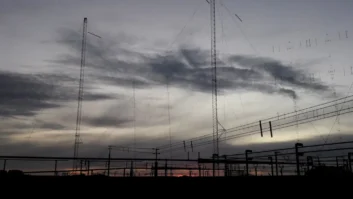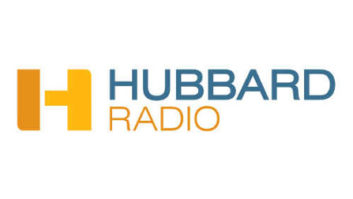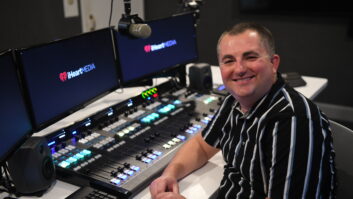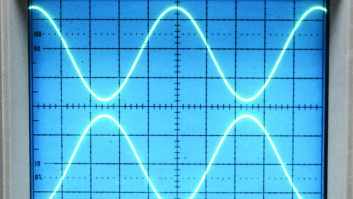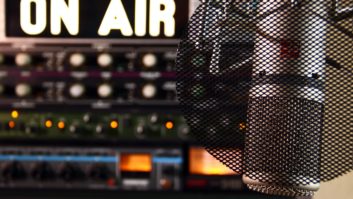Audio Quality on Radio Today
Jul 18, 2013 10:34 AM, By Andy Linton
Do you know what really annoys me?
People who don’t indicate before making a turn. If they’re driving a car at the time it irks me more.
Flies.
Bed undersheets with those elastic edges that spring up in the night and entomb you, chrysalis-like.
But in my professional life as a broadcast engineering consultant, what really annoys me, is bad quality audio.
I’ve been embroiled in this profession, industry, vocation, hobby, whatever you call it, for over 30 years now. I am a child of the razor blade and splicing-tape age, the valve (tube)-containing transmitter era and the vinyl record-to-CD epoch.
I’ve watched as those lethal tools of our trade were consigned to the analls of history and the subjects of anecdotes to audiences of incredulous interns.
And in all that time I have strived to ensure that the best quality, the least distorted audio, the nicest possible sound was caused to pour, mellifluously, from the loudspeakers of grateful listeners.
Back in the halcyon days of back-cueing, valves [tubes] drifting out of spec, and oxide-shedding tape, it was actually quite a challenge against the limits of the technology available to ensure that faithful reproduction via the electromagnetic spectrum was attained; at one station I worked, the styli were replaced every two weeks. At another, which played all audio from NAB carts, the tape heads were cleaned (by me) twice a day and demagnetized every week.
We had to realign the tape heads periodically as they wore, with consequent azimuth errors. Vinyl records would start to sound dull or distorted (particularly towards the center of the disc) and would have to be either replaced or consigned to tape before they got too bad.
The AM transmitter required constant attention as the bias drifted, the antenna was monitored and retuned to ensure linear bandwidth and the correct impedance; the whole transmission chain, from mixing desk via jack-fields (with their annoying habit of developing a bad connection on their own when no-one had gone near them) to studio-transmitter links was swept and analyzed to ensure everything was spot-on.
It was difficult, in those far-off times, to produce good-quality radio.
But we did it.
Oh! How we rejoiced, when the Digital Age came amongst us. Complicated, vulnerable sine waves were to be replaced by invincible ones and indestructible zeros. Incorruptible digital signals would bestride our facilities, shrugging off all hitherto foes, and emerge, unscathed, into the listeners’ auditory environment.
But I fear that these days, all is not as pristine as it should be. It seems new technology has, in fact, produced worse quality radio!
My, oh my. I hear and witness some terrible things these days.
When computer playout systems came along, I could see how these brilliant tools could be used to create even better radio. Instead of spending all the time while a song was playing getting the next record out, cueing it up, getting out the carts for the stop-set, manually checking for duration and voice clashes, the presenter could instead consider how best to present his next link as a sparkling, clever, concise and perfect example of his art.
Instead, they now seem to spend this newly freed-up time watching TV, reading the newspaper, twittling or updating the Book of Face.
But that’s a rant for another day.
With the introduction of hard-disk storage, I thought “Great!” No more azimuth problems, no more dirty tape heads, no more cue-burns, no more surface noise, no more wowing due to off-centre spindle holes, no more worn-stylus distortion.
But of course, because in the mid-nineties hard drives cost more than the GNP of a small country for even modest storage capacity, we were forced to embrace bit-rate reduction. Data compression. Still, the early systems with MP2 extensions on their filenames still sounded OK.
– continued on page 2
Audio Quality on Radio Today
Jul 18, 2013 10:34 AM, By Andy Linton
But no-one seemed to bother to tell audio editing-types that, after opening an MP2 file in their new-fangled PC-based editing software, they should be very careful when saving the resulting audio as an MP2 because it could cause the software to compress it further.
The cost/capacity of hard-disk storage has, of course, become far more realistic in recent times; so most if not all computerized playout systems now store the audio as linear, non-compressed files. But I do still see a lot of use of MP3 files on air, which disappoints me greatly.
I know of at least one FM station, who rejoice in an ‘all-digital’ transmission chain, where commercials are received as MP3 files via email, opened by a person employed in commercial traffic in Adobe Audition, topped/tailed, trimmed and normalized, and saved again as an MP3. The warning that pops up to alert of the tragic consequences of saving to a lossy format isn’t even read. It probably isn’t even seen, before being summarily okayed.
This file is then imported into the playout system that converts it to a WAV file.
It’s a WAV file, therefore good quality, right? Wrong. That poor audio has by then been subject to at least one particularly vicious bit-rate-reduction process, which if the MP3 was at 128kb/s, means it now contains only one eleventh of the data it did when virgin.
The plight of all those bits of audio that no longer exist seems to be of no interest. I feel for them, however; Mother Nature, after all, decided that they were all needed for us to accurately perceive the sound they represent – so who are we to discard them with such gay abandon?
Of course, whether we actually notice their absence is debatable. In the example above though, most people can notice the difference. Data reduction of a factor of eleventy-one is pretty severe.
I have seen, with my own fair eyes, someone playing a song on air off YouTube. The appalling swirliness of the audio on air seemed to matter not a jot, if it was even noticed by the bold presenter.
I do not have a propensity for physical violence, but upon witnessing this I can tell you, my perturbation was palpable, and had I been of pugilistic tendency, blows may have been wrought.
If you’re just saving your legally obtained album to your iPod, and you’re going to listen to it on loudspeakers so tiny that they fit right in your ear, then it probably doesn’t matter.
But we – and I mean us, in the broadcast industry – are imparting that audio to our customers. Surely it’s beholden upon us to do so in the most accurate way possible?
Besides, that poor, stripped-down piece of audio may well subsequently be squeezed down a studio-transmitter link that reduces the bitrate again. It might be converted from digital to analog and analog to digital several times before it presents itself, exhausted, to our faithful listeners.
You know those excellent novelty birthday cards, which impart mirth and joy by means of a built-in recording of someone singing ‘happy birthday’? You know how crunchy and distorted they sound? Well I routinely hear commercials on FM radio that rival that quality for awfulness.
Audio processing
Which reminds me to write of the hoary old chestnut that is audio processing. I am a great fan of it; but only when done properly.
When the venerable Optimod-FM 8100 came amongst us in the early 1980s, it was actually quite difficult to put one on air and make it sound bad. There were varying degrees of niceness attainable, but with only five knobs, it was practically impossible to set the unit up to sound horrid.
“Give me five knobs, and I will give you the world,” someone once said. Possibly.
The clever stuff was by dint of the properties of resistors, capacitors and inductors – those esoteric old analog components used in particular configuration to great effect by Mr. Orban, father of the Optimod.
But when the ones and zeros came along, it became much easier to add myriad other controls – as you didn’t need a physical knob for each one, all million of them could be represented by a picture on a display. Later, more unruly progenies of Mr. Orban and his competitors had adjustments rejoicing in such nomenclature as Delta AGC; MB Release; HF Enhance; Sideways DownUp – all there on a nice LED or some other display and all nicely messuppable.
“Give them lots of knobs, and they will turn them,” someone else said, maybe. And turn them they do, until they’ve knotted themselves up in a conundrum within an enigma, the audio sounds like it has passed through a vacuum-cleaner pipe, and no one is happy.
– continued on page 3
Audio Quality on Radio Today
Jul 18, 2013 10:34 AM, By Andy Linton
And about levels
Levels. If I had a euro/dollar/yen for every time I’ve heard someone say “you don’t have to worry about levels, the audio processor will fix it”, maybe I wouldn’t be a millionaire, but I would be able to buy a lot of lottery tickets which might make me one.
In the halcyon days before clever audio processors, men with glasses and a tweed jacket, and a finger on an attenuator, used to continuously scrutinize the audio levels leaving a studio and heading towards the transmitter, lest a stray peak caused some over-modulation.
Then the audio processors came along, with their ability to react to audio peaks even faster than our bespectacled friend, so he was pensioned off and before long the above mantra entered the vernacular.
I wish it hadn’t, and I spend a good deal of my time on earth trying to disabuse radio people of that notion. Desk (console) levels are important: First, to ensure that the processor (which is doing a lot more things than simply emulating an earnest man) gets fed with the best level for it to work with, and second but not least, to ensure that the transition between consecutive items of program material is consistent.
Have you ever listened to a news broadcast in which the news guy says something like “Arnie Farnsbarn reports”, and Arnie’s voice level creeps slowly up from the doldrums, only becoming clearly audible just before he performs his outcue? That’s because the newsreader’s mic level was far higher than the clip, and the processor took time to recover.
The processor couldn’t fix it.
Hard limiting
I know of a gentleman of these shores who earns his living training folk to be radio people. Producers, journalists, jockeys of discs. In his module on audio editing, he actually instructs his pupils to pass their completed piece through a process known in Adobe Audition as Hard Limiting.
C2F I call it; the C stands for Clipping, decency prevents me from explaining what the F represents in this sense.
Actually, it’s introducing distortion. I spend my whole life designing radio station systems which exhibit as little distortion as possible, only for some idiot of a teacher to tell people to put it back in.
“It makes the audio sound louder,” he says. Well, it actually makes it sound distorted. Our listeners’ radios have a volume knob to use if they want it louder or quieter – but they don’t have a distortion knob if they want less of that.
The upshot is this: New, clever, oh-so-shiny digital technology might do things better, faster, bigger, but it seems to require a new type of expertise to ensure that the results aren’t worse than the bad old analog days.
It requires probably more training these days to instill the knowledge needed to make the most of the technology that arrived at our doors, and to avoid the pitfalls that came along for the ride.
It requires restraint, understanding, experience, and – pride in the fine results of your work.
Without these faculties, we are simply not making the most of the achievements of others, far cleverer than ourselves, who have bestowed upon us the marvels of modern broadcast technology.
So there you have it � that”s why flies, and bad audio quality on radio, annoy me.
There”s no need.
Linton is a director of Total Broadcast Consultants Ltd. in Ireland.






